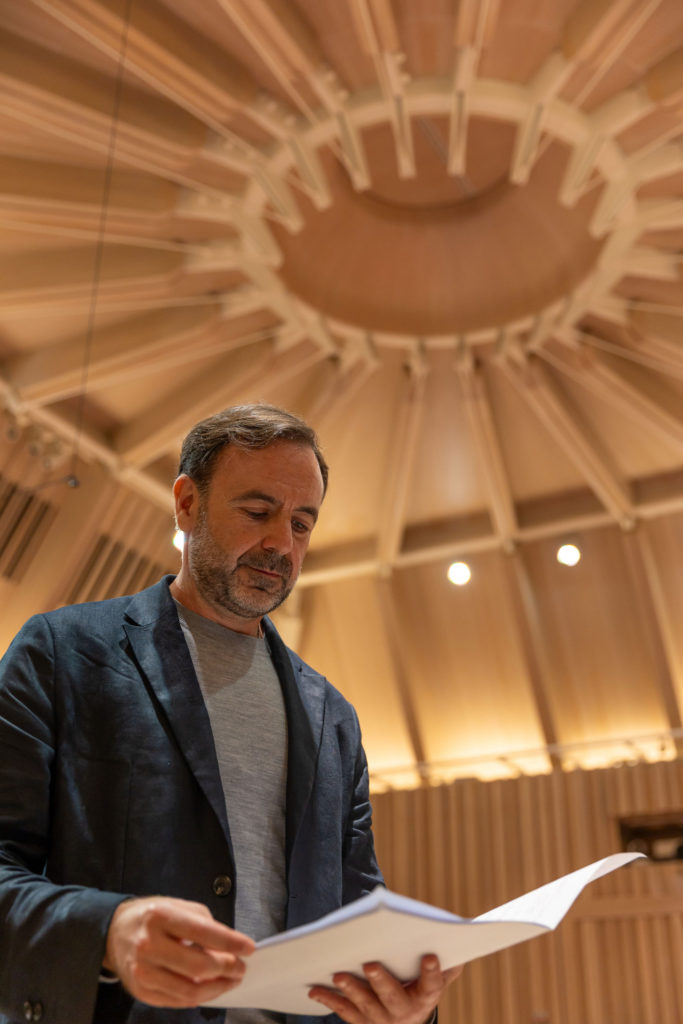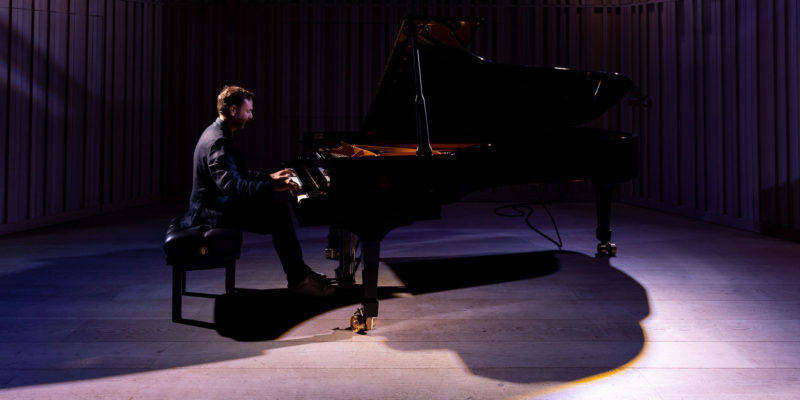Award-winning composer, pianist and soundtrack creator Javier Rodriguez has built up an unrivalled repertoire over the years, creating renowned music and projects for TV, media, brands and institutions across the globe.
As well as being the former Musical Director of the World Ballet, the Spanish-born musician has performed on a multitude of international stages, and has participated in numerous celebrated collaborations and film scores.
We were blessed with the opportunity to interview Javier Rodriguez, to find out more about his inspiring journey, where it started, what moves him, his ambitions, his upcoming projects, and plenty more. Here’s the conversation in full.
* * *
Hi Javier – a real pleasure to connect, thanks for your time! To introduce things, where are you right now, and what have you been working on these past weeks?
Thank you, the pleasure is truly mine. At this moment, I’m in transit—both literally and creatively. I’ve been recording across Asia and Australia, places where the sounds and silences have a particular resonance. Simultaneously, I’m promoting my latest work, The Road Less Travelled, in the UK—a project close to my heart.
My current focus is also anchored in Mumbai, where we’re polishing the final nuances of a couple of cinematic scores. There’s a sensation of perpetual motion these days and it allows new colors to seep into the music.
Growing up in Spain, how old were you when music first impacted and inspired you, and who or what first initiated that?
I think music has always been there, like a companion in the shadows, even before my earliest memories. I was fortunate to grow up in Lucena, a town that somehow vibrates with music—the conservatories in Lucena and Córdoba were central to my upbringing.
But more importantly, it was the sense of belonging to a musical family and community; learning from the local maestros, particularly the Chicano family, and later Rafael Orozco, brought this powerful realization that music was not only an art form, but a language you spoke with your whole self.
What was it about the piano that drew such passion from you?
The piano, for me, is almost a neurological extension of the self—a gateway to translate the intangible into the tangible. There are studies in neuroscience showing how, through years of practice, an instrument becomes integrated into your neural map—it’s the phenomenon where the boundary between body and instrument fades.
The piano, in particular, with its vast architecture, its ability to orchestrate both harmony and rhythm under ten fingers, gives you this extraordinary range of expression. And in the end, it’s about touch—how even the lightest pressure is a direct output of thought and emotion. It still fascinates me.
How did you come to connect with legendary pianist Rafael Orozco, and what did this training bring out in your natural ability and mindset?
Rafael Orozco was, in many ways, an artistic icon. He was from Priego de Córdoba, just next to my hometown, and his visits to Lucena were always events, imbued with an atmosphere almost liturgical in its intensity. I made the journey to Priego as a young musician, drawn by an ineffable curiosity. What struck me about Rafael was not only his technical brilliance, but his deep humanity—a sense that art and life are interconnected stories.

You’ve composed and released a multitude of original scores for film and theatre, as well as musical collaborations and your own solo projects. Which piece from your repertoire would you recommend today, if listeners only have time to hear one, and why?
That’s always a challenging question, as each piece is a snapshot of a particular emotional or philosophical landscape. Today, I think I’d point listeners to my soundtrack for Un Jour Viendra, a project with Nicolas Cazalé during the lockdown.
There’s something unique about music made in isolation: it can carry both longing and hope, shadow and light. That score, recorded despite boundaries and distances, feels especially timely as it quietly interrogates connection, memory, and resilience. It is a sonic letter from that peculiar moment in time.
How important has the production side of things been, and what was the learning process like for the electronic counterparts, as opposed to organically practicing an instrument and composing in real time?
Production has always felt like a parallel universe to me—an infinite extension of the possibilities of sound. There’s a powerful cinematic potential in electronic music—an ability to sculpt landscapes that don’t exist in the physical world.
I’ve always admired what Vangelis did in Blade Runner, or what Jon Hopkins and Jóhann Jóhannsson have achieved: these are artists who understand that technology isn’t antithetical to emotion, but can in fact deepen it.
“The key has been to see electronics not as a substitute, but as another dialect. In the studio, it’s a delicate dance—balancing the instincts honed at the piano with the vast experimental field of digital sound.”
What was the inspiration for the album Morpheus, and how different is it to compose a themed, cinematic and atmospheric ambiance, over something stripped back or neo-classical?
Morpheus was a commission from the East London School of Yoga and my dear friend Stewart Gilchrist. It’s very much rooted in the therapeutic—that intersection between sound, healing, and consciousness. Inspired by Nada Yoga, which seeks to align internal and external vibrations, the album is mapped as a journey out of insomnia—each piece is written to encourage a sense of surrender, a gentle detachment from the noise of waking life.
The approach is almost architectural: atmospheric, intentional, meditative. Unlike solo piano or neo-classical work, where narrative drives the form, here it’s about holding a safe space—a sonic cradle for the listener to rest, to drift.
You’ve also built up a significant audience, and won awards for your music – how do you maintain an organic and grounded approach to music, when expectations are higher, and you suddenly have a reputation to uphold; how do you hold on to authenticity and not steer towards simply satisfying existing audiences?
That’s a challenge every artist faces, especially in an age that rewards repetition. For me, authenticity is non-negotiable. My inner motto is simple: play what you mean, mean what you play. Awards and expectations exist outside the music; inside, the only metric is honesty. Each project is a new beginning, a new set of questions to answer.
“I see the audience not as clients to satisfy, but as companions on a shared journey—we meet through sincerity and risk, not through comfort.”
When I start to feel pressure, I try to return to first principles: why do I make music at all? There, on the blank page or empty studio, I rediscover the joy and necessity of exploration.
Your journey has been a diverse and well-travelled one. Which experience comes to mind as one of the most unforgettable for you as a musician and composer, and why?
Every journey reshapes you. India was a revelation, working and listening with Ravi Shankar—I witnessed how music could be cosmic and intimate at once. In Brazil, jamming with Elio Delmiro and Daniella Mercury, I saw how rhythm and melody could be a force of life itself. Cuba, with Irakere, was electrifying—music as celebration, as defiance. Each place—Europe, Asia—left its imprint and each collaboration tugged at different corners of my creative self. What stays with me most is the sense that music is a global nervous system; everywhere, it is a way to connect, to cross borders that exist only in the mind.
What’s your biggest ambition now, as the second half of 2025 swings into view?
I’m imagining—a little mischievously—a kind of music lab without walls called “The Nest”: a place where composers, performers, thinkers, and dreamers from everywhere can collide, experiment, and re-invent what music can be. A kind of 21st-century Bauhaus, but for sonic innovation!
The idea makes me smile because who knows what ‘reinventing a music lab’ actually means? But sometimes you need to leap before knowing. The ambition is to connect people and cultures in ways that are surprising, disruptive, and above all, joyful.
What’s the best way for fans or aspiring musicians and collaborators to get in touch with you?
You can reach me through my website www.javierrodriguez.org, or on Instagram and YouTube at @javierodriguezmusic. I do try to answer messages personally, so please don’t hesitate. The best ideas often begin as a simple hello.
* * *
Find Javier Rodriguez on Instagram & his Website.

